Beautiful German leading lady Anita Dorris (1903-1993) started as a stage actress in 1921, after which some 15 silent films followed. Dorris was beloved in the late 1920s and smoothly made the passage to sound. In 1930, she married Austrian film director E. W. Emo and withdrew from the cinema. Her daughter, Maria Emo, would also become a well-known stage and film actress.
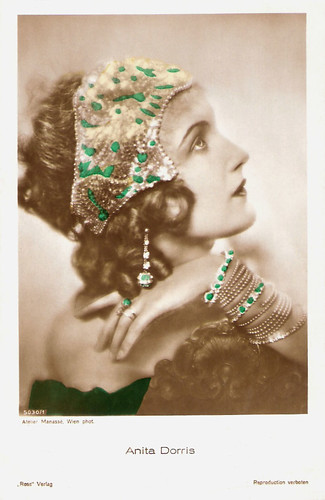
German postcard by Ross Verlag, no. 5030/1, 1930-1931. Photo: Atelier Manassé, Vienna.
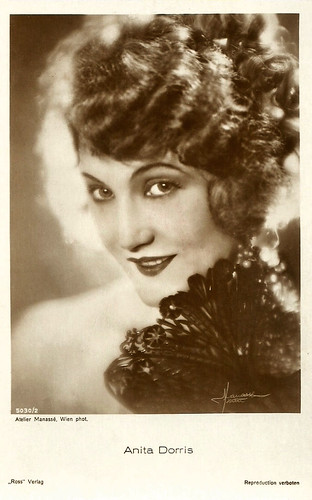
German postcard by Ross Verlag, no. 5030/2, 1930-1931. Photo: Atelier Manassé, Vienna.

Austrian postcard by Iris-Verlag, no. 5395. Photo: Atelier Manassé.
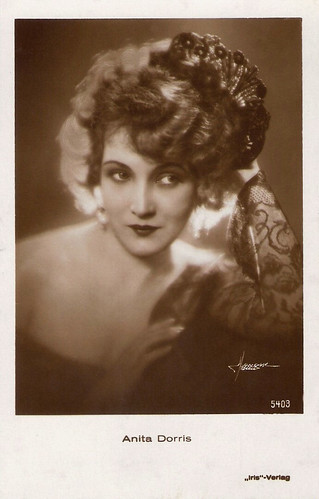
Austrian postcard by Iris Verlag, no. 5403. Photo: Atelier Manassé, Wien.
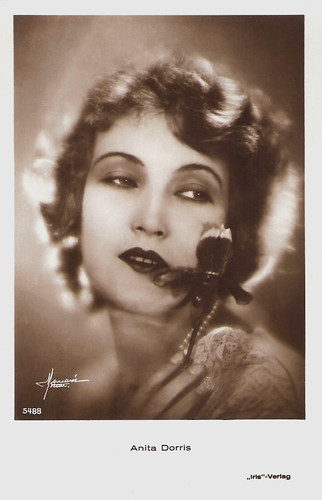
Austrian postcard by Iris-Verlag, no. 5488. Photo: Atelier Manassé.
Anita Dorris was born Anita Dorothea Schmidt in 1903 in Lübeck, Germany. She was the daughter of Ernst Schmidt, the owner of a printing company.
In 1921, because of her acquaintance with Anton Kohl, Anita got her first engagement as a stage actress at the Stadttheater Eger. She moved on to theatres in the cities of Pilsen and Franzensbad, and from 1923 to 1925 she worked in Prague. Her film career started by accident. She acted for a friendly cameraman who wanted to apply for a job with director Friedrich Zelnik (aka Frederic Zelnik) with a sample of his skill. However, Zelnik didn't pay attention to the work of the cameraman but was enthusiastic about the acting by Schmidt.
He engaged her for his film Die Mühle von Sanssouci/The Mill of Sanssouci (Siegfried Philippi, Friedrich Zelnik, 1926), and Anita Schmidt changed her name to Anita Dorris. In her film debut, she appeared with the stars Otto Gebühr and Olga Tschechova, and soon some 15 more silent films followed.
She worked on three films with Dutch director Jaap Speyer: Liebeshandel/Love Affair (1927), Bigamie/Bigamy (1927) and Die Sache mit Schorrsiegel/The Schorsiegel Case (1928). According to Thomas Staedeli at Cyranos, her most impressive performance was Trilby in the drama Svengali (Gennaro Righelli, 1927) opposite Paul Wegener in the title role.
Dorris also played Friederike of Prussia in both Die Jugend der Königin Luise/Königin Luise I/Queen Louise and Königin Luise II (Karl Grune, 1927), based on screenplays by Ludwig Berger.
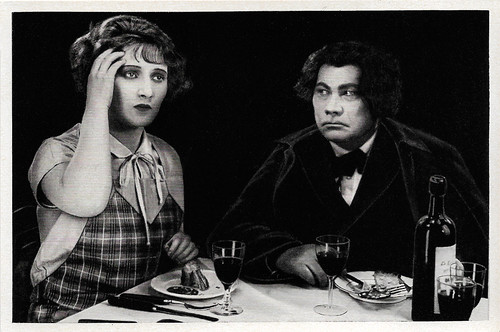
German collectors card by Ross Verlag in the series Vom Werden Deutscher Filmkunst - Der Stumme Film, picture no. 135, group 43. Photo: Terra Film. Publicity still for Svengali (Gennaro Righelli, 1927) with Paul Wegener.
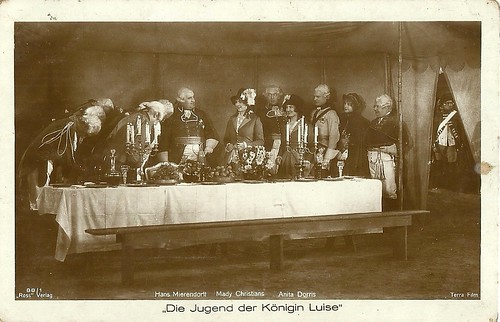
German postcard by Ross Verlag, no. 88/1. Photo: Terra Film. Mady Christians, Anita Dorris and Hans Mierendorff in Die Jugend der Königin Luise/Königin Luise I (Karl Grüne, 1927).
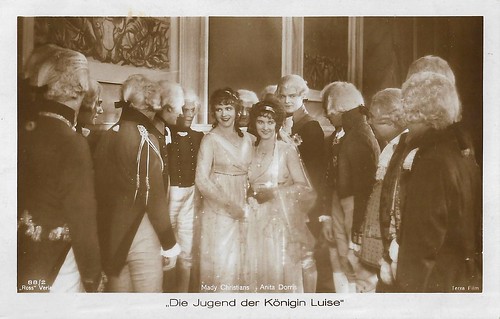
German postcard by Ross Verlag, no. 88/2. Photo: Terra Film. Mady Christians as Louise and Anita Dorris as her sister Friederike in Königin Luise, 1. Teil - Die Jugend der Königin Luise/Queen Louise (Karl Grune, 1927).
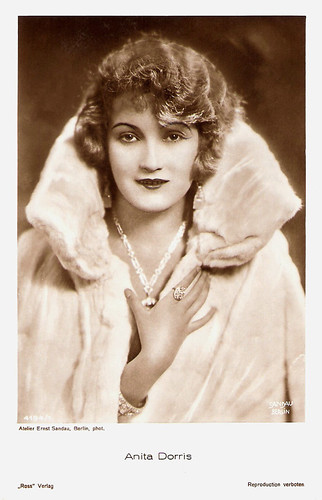
German postcard by Ross Verlag, no. 4194/1, 1929-1930. Photo: Atelier Ernst Sandau, Berlin.
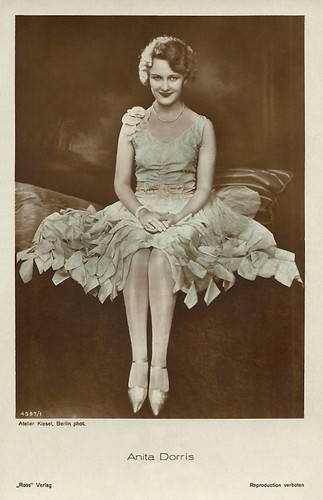
German postcard by Ross Verlag, no. 4597/1, 1929-1930. Photo: Atelier Kiesel, Berlin. Collection: Didier Hanson.
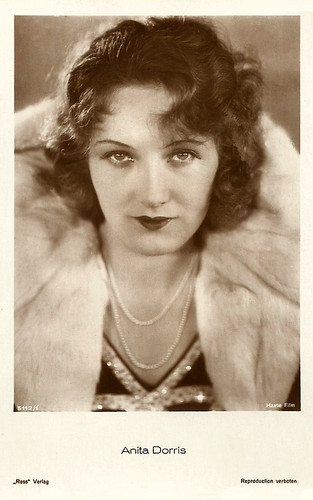
German postcard by Ross Verlag, no. 5112/1, 1930-1931. Photo: Hasse Film.
Anita Dorris was beloved in the late silent film era and with her stage-trained voice, she smoothly made the passage to sound film.
In 1929, she appeared in the first German sound film, the short Mein Traum wär ein Mädel/My Dream Was a Girl (E.W. Emo, 1929) with Rudolf Platte.
She also co-starred in the prestigious German-Swedish coproduction Mach die Welt ein Paradies/Make the World a Paradise for Me (Paul Merzbach, 1930), opposite Swedish actor Gösta Ekman, the star from F.W. Murnau's Faust.
That same year 1930, however, her promising film career came abruptly to an end. She married film director E.W. Emo and she retired from the cinema at his request. Her final film was Student sein, wenn die Veilchen blühen/Student Life in Marry Springtime (Heinz Paul, 1931) with Fred Louis Lerch.
Ever since 1939, Anita Dorris lived in Vienna, where she died in 1993. Her daughter, Maria Emo (1936), would become a well-known stage and film actress in the 1950s.
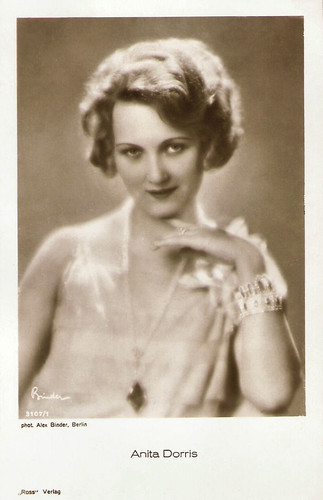
German postcard by Ross Verlag, no. 3107/1, 1928-1929. Photo: Alex Binder, Berlin.
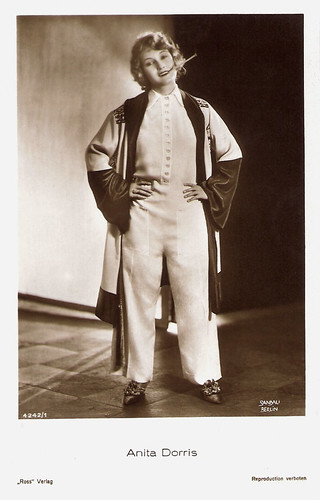
German postcard by Ross Verlag, no. 4242/1, 1929-1930. Photo: Sandau, Berlin.
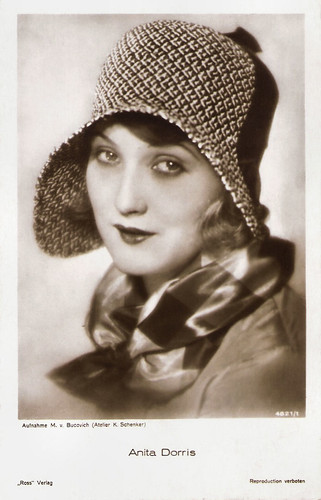
German postcard by Ross Verlag, no. 4821/1, 1929-1930. Photo: M. von Bucovich (Atelier K. Schenker).
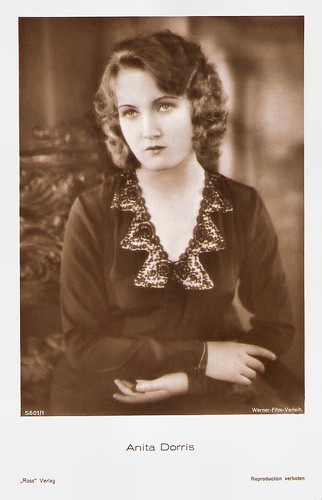
German postcard by Ross Verlag, no. 5601/1, 1930-1931. Photo: Werner-Film-Verleih.
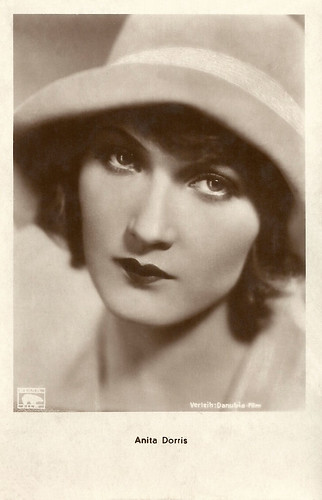
Austrian postcard by Iris Verlag, no. 6031. Photo: Bear Film. Distr. / Danubio-Film.

Austrian postcard by Iris-Verlag, no. 6142. Photo: Verleih Deutsche Tonfilme Leopold Barth & Co. Anita Dorris in Mach' mir die Welt zum Paradies/Make the world a paradise for me (Paul Merzbach, 1930).
Sources: Thomas Staedeli (Cyranos), Wikipedia (German), and IMDb.
This post was last updated on 23 January 2024.

German postcard by Ross Verlag, no. 5030/1, 1930-1931. Photo: Atelier Manassé, Vienna.

German postcard by Ross Verlag, no. 5030/2, 1930-1931. Photo: Atelier Manassé, Vienna.

Austrian postcard by Iris-Verlag, no. 5395. Photo: Atelier Manassé.

Austrian postcard by Iris Verlag, no. 5403. Photo: Atelier Manassé, Wien.

Austrian postcard by Iris-Verlag, no. 5488. Photo: Atelier Manassé.
Film actress by accident
Anita Dorris was born Anita Dorothea Schmidt in 1903 in Lübeck, Germany. She was the daughter of Ernst Schmidt, the owner of a printing company.
In 1921, because of her acquaintance with Anton Kohl, Anita got her first engagement as a stage actress at the Stadttheater Eger. She moved on to theatres in the cities of Pilsen and Franzensbad, and from 1923 to 1925 she worked in Prague. Her film career started by accident. She acted for a friendly cameraman who wanted to apply for a job with director Friedrich Zelnik (aka Frederic Zelnik) with a sample of his skill. However, Zelnik didn't pay attention to the work of the cameraman but was enthusiastic about the acting by Schmidt.
He engaged her for his film Die Mühle von Sanssouci/The Mill of Sanssouci (Siegfried Philippi, Friedrich Zelnik, 1926), and Anita Schmidt changed her name to Anita Dorris. In her film debut, she appeared with the stars Otto Gebühr and Olga Tschechova, and soon some 15 more silent films followed.
She worked on three films with Dutch director Jaap Speyer: Liebeshandel/Love Affair (1927), Bigamie/Bigamy (1927) and Die Sache mit Schorrsiegel/The Schorsiegel Case (1928). According to Thomas Staedeli at Cyranos, her most impressive performance was Trilby in the drama Svengali (Gennaro Righelli, 1927) opposite Paul Wegener in the title role.
Dorris also played Friederike of Prussia in both Die Jugend der Königin Luise/Königin Luise I/Queen Louise and Königin Luise II (Karl Grune, 1927), based on screenplays by Ludwig Berger.

German collectors card by Ross Verlag in the series Vom Werden Deutscher Filmkunst - Der Stumme Film, picture no. 135, group 43. Photo: Terra Film. Publicity still for Svengali (Gennaro Righelli, 1927) with Paul Wegener.

German postcard by Ross Verlag, no. 88/1. Photo: Terra Film. Mady Christians, Anita Dorris and Hans Mierendorff in Die Jugend der Königin Luise/Königin Luise I (Karl Grüne, 1927).

German postcard by Ross Verlag, no. 88/2. Photo: Terra Film. Mady Christians as Louise and Anita Dorris as her sister Friederike in Königin Luise, 1. Teil - Die Jugend der Königin Luise/Queen Louise (Karl Grune, 1927).

German postcard by Ross Verlag, no. 4194/1, 1929-1930. Photo: Atelier Ernst Sandau, Berlin.

German postcard by Ross Verlag, no. 4597/1, 1929-1930. Photo: Atelier Kiesel, Berlin. Collection: Didier Hanson.

German postcard by Ross Verlag, no. 5112/1, 1930-1931. Photo: Hasse Film.
The first German sound film
Anita Dorris was beloved in the late silent film era and with her stage-trained voice, she smoothly made the passage to sound film.
In 1929, she appeared in the first German sound film, the short Mein Traum wär ein Mädel/My Dream Was a Girl (E.W. Emo, 1929) with Rudolf Platte.
She also co-starred in the prestigious German-Swedish coproduction Mach die Welt ein Paradies/Make the World a Paradise for Me (Paul Merzbach, 1930), opposite Swedish actor Gösta Ekman, the star from F.W. Murnau's Faust.
That same year 1930, however, her promising film career came abruptly to an end. She married film director E.W. Emo and she retired from the cinema at his request. Her final film was Student sein, wenn die Veilchen blühen/Student Life in Marry Springtime (Heinz Paul, 1931) with Fred Louis Lerch.
Ever since 1939, Anita Dorris lived in Vienna, where she died in 1993. Her daughter, Maria Emo (1936), would become a well-known stage and film actress in the 1950s.

German postcard by Ross Verlag, no. 3107/1, 1928-1929. Photo: Alex Binder, Berlin.

German postcard by Ross Verlag, no. 4242/1, 1929-1930. Photo: Sandau, Berlin.

German postcard by Ross Verlag, no. 4821/1, 1929-1930. Photo: M. von Bucovich (Atelier K. Schenker).

German postcard by Ross Verlag, no. 5601/1, 1930-1931. Photo: Werner-Film-Verleih.

Austrian postcard by Iris Verlag, no. 6031. Photo: Bear Film. Distr. / Danubio-Film.

Austrian postcard by Iris-Verlag, no. 6142. Photo: Verleih Deutsche Tonfilme Leopold Barth & Co. Anita Dorris in Mach' mir die Welt zum Paradies/Make the world a paradise for me (Paul Merzbach, 1930).
Sources: Thomas Staedeli (Cyranos), Wikipedia (German), and IMDb.
This post was last updated on 23 January 2024.
No comments:
Post a Comment